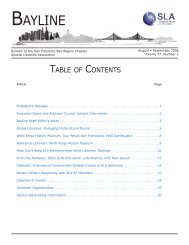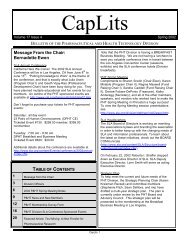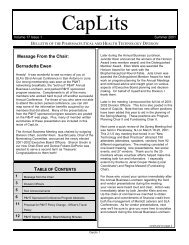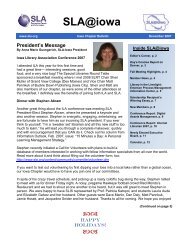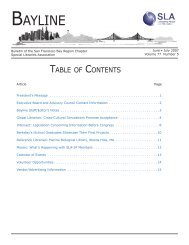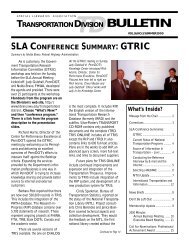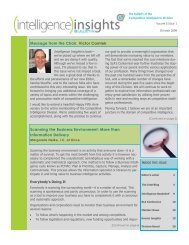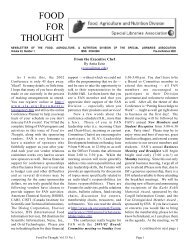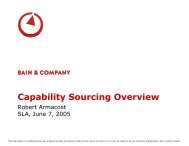Education Libraries - Special Libraries Association
Education Libraries - Special Libraries Association
Education Libraries - Special Libraries Association
You also want an ePaper? Increase the reach of your titles
YUMPU automatically turns print PDFs into web optimized ePapers that Google loves.
used in presentations<br />
• Records Management: for managing both<br />
electronic and paper records<br />
• Vocabulary Control: for creating and<br />
maintaining thesauri to facilitate the<br />
indexing and retrieval of your data<br />
Background<br />
The Digital and Multimedia Center at my<br />
organization has a collection of historical items<br />
across many different subjects. Our collections are<br />
currently housed in a mySQL database that was<br />
created in-house and served through a JSP coded<br />
front end. Our current functionality has browsing<br />
for individual items at the book level and searches<br />
only at the title and author level. We have several<br />
serials digitized in our collection but no way to<br />
offer article level searching of our serials. We<br />
decided to create a prototype of article level<br />
searching to see if the software would work for us<br />
and how difficult it would be to create and<br />
maintain.<br />
This review focuses on the creation of the<br />
database, data entry and display of the database<br />
information, including a walkthrough of each step<br />
of the process. Since we already had an<br />
installation of the STAR database I did not install<br />
or set up any of the software on the server itself so<br />
I will not be reviewing that portion of the<br />
software.<br />
Metadata Setup<br />
One of the advantages of working<br />
with STAR is the ability to create<br />
whatever metadata schema you’d<br />
like to use, although it has a few<br />
constraints. It is also versatile<br />
enough to allow you to develop the<br />
schema you need. I worked with<br />
our metadata librarian to choose a<br />
schema for the prototype. We<br />
wanted to make sure that STAR<br />
could accept the fields we would<br />
like to use and make sure that it<br />
was forward compatible with any<br />
other system we would migrate to<br />
in the future. We chose Metadata Object<br />
Description Schema (MODS) to start. I worked<br />
with both the metadata librarian and the database<br />
administrator of STAR to negotiate what would<br />
work within STAR.<br />
For the most part, the input fields of MODS would<br />
work in the STAR database, however, we did have<br />
to do some modification of the schema to make it<br />
work. The MODS schema has subfields of<br />
subfields, however, STAR would only accept one<br />
subfield. For example, for the tag which contains a subfield which has subfield called<br />
. Because STAR does not support<br />
subfields with subfields we needed to create a<br />
work around. We decided to include manually in the data dump if we move<br />
to a new system. Since the material we were<br />
putting into the database was relatively<br />
homogeneous, this seemed to be a good work<br />
around.<br />
Overall, choosing the metadata schema and<br />
matching it to what STAR could do was a<br />
relatively painless process. That it was flexible<br />
enough to handle the different metadata schemas<br />
is a real positive. We could use different metadata<br />
schemas for different databases and collections<br />
which makes the database system extensible and<br />
desirable.<br />
<strong>Education</strong> <strong>Libraries</strong>, Volume 31, No. 2, Winter 2008 43



